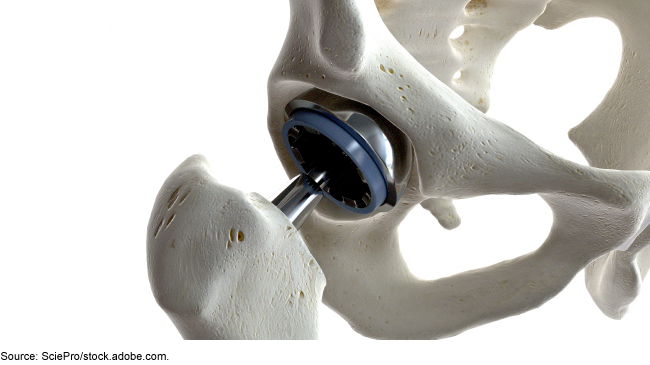Veterans Health Care: Improvements Needed in Patient Tracking for Non-Biological Implantable Medical Devices
Fast Facts
What happens when there's a recall of a pacemaker, hip implant, or other implantable medical device—after it's already in a patient? If the patient is a veteran, the Veterans Health Administration needs to ensure that health care providers can contact them for follow-up care.
But VHA's policies don't ensure that all such devices are effectively trackable. For example, if VHA needed to identify all patients with a specific orthopedic implant, it would have to do a time-intensive search of patients' individual medical records. Cardiac electronic devices, however, are tracked separately from the patient record.
Our recommendations address this.
3D rendering of a hip implant

Highlights
What GAO Found
Multiple Veterans Health Administration (VHA) offices are involved in overseeing implantable medical devices received by veterans. VHA's National Center for Patient Safety, the lead office for patient safety issues, is responsible for monitoring device safety issues. This office evaluates patient risk when safety issues are identified and collaborates with VHA's clinical program offices to develop VHA's response. National program offices for clinical specialties such as the National Cardiac Device Surveillance Program and the National Surgery Office are also responsible for overseeing cardiac electronic and orthopedic devices, respectively.
GAO found that VHA is unable to ensure that all non-biological implantable medical devices are tracked to individual patients. Such tracking is important so that when a safety issue occurs VHA can ensure patients are notified and receive appropriate care. For the two clinical specialties reviewed, the National Cardiac Surveillance Program was able to effectively track cardiac electronic devices to individual patients, but the National Surgery Office was not able to effectively do so for orthopedic devices. VHA policy requires tracking outside the medical record for cardiac devices but does not require it for orthopedic devices. Accordingly, this gap adversely affects VHA's ability to ensure such tracking is occurring.
Example of Knee and Hip Replacement Implantable Medical Devices

GAO also found VHA has not fully assessed, across all specialties, its ability to ensure that non-biological implantable medical devices can be effectively tracked to individual patients. Officials with the National Center for Patient Safety and others have recognized the need to develop better tracking capabilities across VHA. An assessment of VHA's ability to track all non-biological implantable medical devices across all clinical specialties could help the agency target and prioritize the most critical devices. This would help ensure these patients receive appropriate care in the event of safety issues.
Why GAO Did This Study
VHA provided health care to over 6 million veterans in fiscal year 2022. Such care can include receiving an implantable medical device. The approximately 226,000 implants provided each year by VHA include biological implants made from body tissues, such as skin grafts, or non-biological implants made from materials such as plastic or metal. Examples of the latter include pacemakers and hip replacements.
The James M. Inhofe National Defense Authorization Act for Fiscal Year 2023 includes a provision for GAO to study VHA's oversight of implantable medical devices. This report (1) describes VHA offices that oversee implantable medical devices; (2) describes VHA's monitoring of implant safety issues; and (3) examines how VHA ensures tracking of non-biological implants to individual patients.
GAO reviewed policies, data, safety reports, and other information on non-biological implants with a focus on certain cardiology and orthopedic implants. GAO interviewed officials from VHA and four VA medical centers (and their regional management), selected based on factors such as the volume of cardiology and orthopedic implants, facility size, and location.
Recommendations
GAO recommends VHA (1) add a policy requirement that non-biological orthopedic devices be effectively tracked and (2) assess, across all clinical specialties, its ability to track non-biological implantable devices to individual patients and take actions to address any identified gaps. VHA agreed with GAO's recommendations.
Recommendations for Executive Action
| Agency Affected | Recommendation | Status |
|---|---|---|
| Veterans Health Administration | 1. The Under Secretary of Health should ensure VHA includes requirements in its policies that non-biological orthopedic implantable medical devices be effectively tracked to the patient level and ensure that VHA national-level offices have access to the information from the tracking systems for oversight. (Recommendation 1) |
When we confirm what actions the agency has taken in response to this recommendation, we will provide updated information.
|
| Veterans Health Administration | 2. The Under Secretary of Health should undertake an assessment across all clinical specialties to identify where other gaps exist in its ability to effectively track non-biological implantable medical devices to individual patients and take actions to address any identified gaps. Such actions should include ensuring appropriate policies are in place, requiring the use of data systems for tracking, and ensuring that VHA national-level officials have access to the information from the tracking systems for oversight. Actions may also include identifying one program office with ultimate responsibility for implantable medical device oversight at the national level, which could be one of the national offices such as NCPS or an interdisciplinary team such as VHA's Biological Implant Tracking Integrated Project Team. (Recommendation 2) |
When we confirm what actions the agency has taken in response to this recommendation, we will provide updated information.
|
